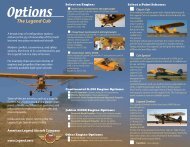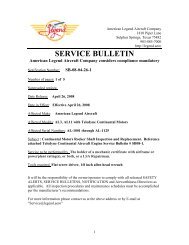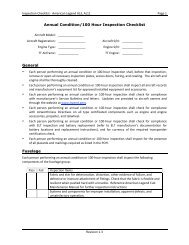detonation at high power output because combustion temperatureand pressure are, of course, higher than they are at low or mediumpowers. Leaning the mixture at high power can cause it.Unless detonation is heavy, there is no cockpit evidence of itspresence. Light to medium detonation may not cause noticeableroughness, observable cylinder head or oil temperature increase,or loss of power. However, when an engine has experienceddetonation, we see evidence of it at teardown as indicated bydished piston heads, collapsed valve heads, broken ring landsor eroded portions of valves, pistons and cylinder heads. Severedetonation can cause a rough-running engine and high cylinderhead temperature.D e t o n a t i o n a n d P r e i g n i -t i o nPREIGNITIONPreignition, as the name implies, means that combustion takesplace within the cylinder before the timed spark jumps acrossthe spark plug terminals. This condition can often be traced toexcessive combustion deposits or other deposits (such as lead)which cause local hot spots. Detonation often leads to preignition.However, preignition may also be caused by high poweroperation at excessively leaned mixtures. Preignition is usuallyindicated in the cockpit by engine roughness, backfiring, andby a sudden increase in cylinder head temperature. It may alsobe caused by a cracked valve or piston, or a broken spark pluginsulator which creates a hot point and serves as a glow spot.Specifically, preignition is a condition similar to early timing ofthe spark. Preignition is a serious condition in the combustionchamber and will cause burnt pistons and tuliped intake valves.The best temporary in-flight methods for correcting preignitionand detonation are to reduce the cylinder temperature by retardingthe throttle, enriching the mixture, opening cowl flaps if available,or a combination of all of these.<strong>Lycoming</strong> Engineering, in their continuing effort to improve our<strong>engines</strong>, developed a better method of manufacturing hardenedalloy steel cylinder barrels a number of years ago by meansof a method known as nitriding. Simply described, the additionof nitrogen to the surface of an alloy steel produced a hard, wearresistantsurface. Commercially, the introduction of nitrogen intothe surface layers of alloy steel is brought about by subjectingthe practically finished <strong>parts</strong> to an atmosphere of ammonia gas.The process requires special heat treating furnaces which areair tight and capable of holding the <strong>parts</strong> at a high temperature.At this heat level (975 o F), the ammonia gas flowing into thefurnace is broken down into its elements of hydrogen andnitrogen, and this is the source of the nitrogen which penetratesthe surfaces of the steel. In order to produce a satisfactorynitrided surface, the process must be operated for an extendedperiod of time, generally from 25 to 80 hours. Along withcylinder barrels, <strong>Lycoming</strong> nitrides all its crankshafts andsome gears.The nitriding process applied to cylinder barrels has been thoroughlyservice tested in military as well as commercial service.After having been FAA type tested, we began production of<strong>engines</strong> using nitrided cylinders in 1960. The service record ofthese cylinders has been excellent. In fact, our management wasso impressed with the favorable service record of the nitridedcylinder that they changed from chrome to nitrided cylindersin all our higher powered turbocharged and supercharged<strong>engines</strong>. Some favorable characteristics of nitrided barrels areas follows:1. Reduced cylinder wall wear - the harder a surface the moredifficult to wear down.2. Natural choked barrels provide improved piston ring life due toa resulting straight cylinder wall when engine is hot or operating,and a better job of sealing.3. Nitriding permits use of chrome plated piston rings, which aremore wear resistant and quite compatible with hardened steel.4. Nitriding provides a hardened surface with an increasedfatigue strength.5. It also has the ability to resist softening when excessively heatedduring engine operation.These worthwhile features in the power plants have meant evenlonger operating life than standard steel barrels, and they meandependability and economy.Now chrome plated cylinders cannot be obtained from the factory,but the identification specification for them has been an orangeband around the cylinder base, or the equivalent color on theedges of the top cylinder head fins between the two valve pushrod shroud tubes. The color coding for the nitrided cylinders isazure blue and will appear in either of the two locations indicatedabove. The band around the cylinder base is used when cylindersare painted black as a separate operation prior to engine assembly.The color coding on the top edges of the cylinder head fins hasbeen used on <strong>engines</strong> painted all gray after assembly.From the service standpoint on nitrided cylinders, thereare three methods of handling an engine at overhaul.1. The barrels can simply be reworked and returned toservice if they are not beyond service limits.2. The barrel can be reground and then chrome plated, butthe factory has achieved better results with nitriding anduses method three.3. The old cylinder may be discarded and replaced witha new one as in the <strong>Lycoming</strong> factory overhaul andrebuild programs.CHROME vs. NITRIDINGEither method provides a satisfactory hard-wearing surface, butapplication of the chrome plate is a critical operation. Engineswith chrome or nitride-hardened barrels have a good wear characteristic,and are more rugged than standard steel barrels. In spiteof hardened barrels, a good, properly maintained air filter is stilla must. Pistons are moving up and down at a rate of more thantwo thousand times per minute, and when dirt or any abrasiveis introduced into the combustion chambers, it causes a lappingprocess which rapidly wears metal away. No engine can digestdirt and give a satisfactory service life.2 0 L y c o m i n g F l y e r
We aren’t attempting to make mechanics out of pilots by writingabout compression ratio in aircraft <strong>engines</strong>, but we desire to helpboth groups by providing a simplified description as it relates toour <strong>engines</strong>.In order to gain a reasonable amount of work from an internalcombustion engine, we must compress the fuel/air mixture duringeach power stroke. The fuel/air charge in the cylinder can be comparedto a coil spring in that the more it is compressed, (withinlimits), the more work it is potentially capable of doing.Engineering tells us that the compression ratio of an engine is acomparison of the volume of space in a cylinder when the pistonis at the bottom of the stroke to the volume of space when thepiston is at the top of the stroke. For example, if there are 140cubic inches of space in the cylinder when the piston is at thebottom and 20 cubic inches of space when the piston is at the topof the stroke, the compression ratio would be 140 to 20 or usuallyrepresented at 7:1.Although we can create a more efficient engine by increasing thecompression ratio, there are limits and a compromise is needed.If the pressure is too high, premature ignition will occur andproduce overheating. Compression ratio is a controlling factorin the maximum horsepower developed by an engine, but it islimited by present-day fuel grades and the high engine speedsand manifold pressures required for takeoff.Our normally aspirated <strong>engines</strong> are generally categorized aseither low-compression or high-compression power plants. Insurveying the complete range of all <strong>Lycoming</strong> engine models,we note that compression ratios vary all the way from a low6.5:1 to a high of 10:1. Engineering has generally established thelow-compression group as those with a compression ratio of 6.5:1to 7.9:1; and the high-compression group from 8:1 and higher.All <strong>Lycoming</strong> <strong>engines</strong> in the high-compression categoryrequire a minimum of Grade 100LL (blue) or 100/130 (green)octane, FAA-approved aviation fuel, and nothing less. Withhigh-compression <strong>engines</strong> we must stress the importance ofthe manufacturer’s recommendations as outlined in the EngineOperator’s Manual or in the Pilot’s Operating Handbook. These<strong>engines</strong> require not only the correct fuel, but the proper oil, precisetiming and a good air filter. All are very important in orderto protect this high-performance power plant.James Watt, Scottish physicist, had an engine problem evenin 1769. Although steam <strong>engines</strong> had been invented before hewas born, they were crude, inefficient machines and only a fewwere in use. So he had, after much experimental work, developeda relatively efficient condensing steam engine, the forerunner ofthe present-day type.Being a good businessman, Watt tried to sell his engineto coal mine operators who were then using draft horses to supplypower to drive the pumps which kept the mines free of water.But the mine owners had <strong>sales</strong> resistance! They insistedon knowing exactly how many horses each engine wouldreplace, or, in other words, the horsepower of the engine. Howmuch work would his steam engine do? This, then, was JamesWatt’s problem.Although simple machines such as sailing vessels, windmills andwaterwheels had been used for centuries, Watt realized that forthe most part, the majority of work in the world had been doneby man and his domesticated animals. Work was measured andpaid for by the day, from “sun to sun.” With the advent of reliableclocks, work was then accounted and paid for by the hour.Evaluating work by this time method, it was assumed that all menand animals could and did perform the same amount of work.This was far from being true.Watt realized that in order to have his steam engine usedby the coal mine operators, he would have to answer theirquestions — “how much work will it do, and how many men andhorses will it replace?” Since the “power” of one horse was a generallyknown and a constant quantity, he would have to determinethe “power” of his engine in order to compare it with the horseswhich it was to replace. His problem then was to define “power.”Power did not mean force. The mine owners cared nothing aboutthe force Watt’s engine might exert. They wanted to know howfast the engine would pump water out of the mine; in other words,how fast will the engine do the work? Simply, that was the definitionof “power.”The methodical physicist experimenting with draft horses usedto operate mine pumps found that, on an average, a horse pullingwith a force equal to a weight of 150 pounds walked 2-½ milesLow CompressionHigh CompressionBy F. F. Rohm, Chief Qualification Engineer (Ret.)This interesting article was written for us by Fred Rohm,who was our Chief Qualification Engineer when he retired.Fred had a career of 44 years in the industry, with a majorityof those years spent at <strong>Lycoming</strong>. Most of his careerat <strong>Lycoming</strong> was as Chief Experimental Engineer, whichestablishes his qualifications to author this kind of article.L y c o m i n g F l y e r 2 1









